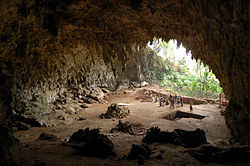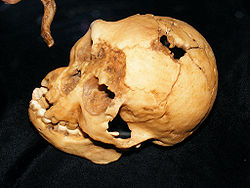
Homo floresiensis
Background Information
This Wikipedia selection is available offline from SOS Children for distribution in the developing world. Before you decide about sponsoring a child, why not learn about different sponsorship charities first?
| Homo floresiensis Temporal range: 94–13 Ka |
|
|---|---|
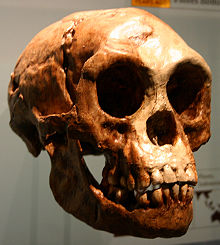 |
|
| A cast of the Homo floresiensis skull, American Museum of Natural History | |
| Scientific classification (disputed) | |
| Kingdom: | Animalia |
| Phylum: | Chordata |
| Class: | Mammalia |
| Order: | Primates |
| Family: | Hominidae |
| Tribe: | Hominini |
| Genus: | Homo |
| Species: | H. floresiensis |
| Binomial name | |
| †Homo floresiensis Brown et al., 2004 |
|
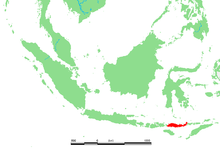 |
|
| Flores in Indonesia, shown highlighted in red | |
Homo floresiensis ("Flores Man", nicknamed " hobbit" and "Flo") is a possible species, now extinct, in the genus Homo. The remains of an individual were discovered in 2003 on the island of Flores in Indonesia. Partial skeletons of nine individuals have been recovered, including one complete cranium (skull). These remains have been the subject of intense research to determine whether they represent a species distinct from modern humans, and the progress of this scientific controversy has been closely followed by the news media at large. This hominin is remarkable for its small body and brain and for its survival until relatively recent times (possibly as recently as 12,000 years ago). Recovered alongside the skeletal remains were stone tools from archaeological horizons ranging from 94,000 to 13,000 years ago.
The discoverers (archaeologist Mike Morwood and colleagues) proposed that a variety of features, both primitive and derived, identify these individuals as belonging to a new species, H. floresiensis, within the taxonomic tribe of Hominini. Hominini currently comprises the extant species Homo sapiens (the only living member of the genus Homo), bonobo (genus Pan), and chimpanzee (genus Pan); their ancestors; and the extinct lineages of their common ancestor. The discoverers also proposed that H. floresiensis lived contemporaneously with modern humans on Flores.
Doubts that the remains constitute a new species were soon voiced by the Indonesian anthropologist Teuku Jacob, who suggested that the skull of LB1 was a microcephalic modern human. Two studies by paleoneurologist Dean Falk and her colleagues (2005, 2007) rejected this possibility. Falk et al. (2005) has been rejected by Martin et al. (2006) and Jacob et al. (2006), but defended by Morwood (2005) and Argue, Donlon et al. (2006).
Two orthopedic researches published in 2007 both reported evidence to support species status for H. floresiensis. A study of three tokens of carpal (wrist) bones concluded there were similarities to the carpal bones of a chimpanzee or an early hominin such as Australopithecus and also differences from the bones of modern humans. A study of the bones and joints of the arm, shoulder, and lower limbs also concluded that H. floresiensis was more similar to early humans and apes than modern humans. In 2009, the publication of a cladistic analysis and a study of comparative body measurements provided further support for the hypothesis that H. floresiensis and Homo sapiens are separate species.
Critics of the claim for species status continue to believe that these individuals are Homo sapiens possessing pathologies of anatomy and physiology. A second hypothesis in this category is that the individuals were born without a functioning thyroid, resulting in a type of endemic cretinism ( myxoedematous, ME).
Discovery
The specimens were discovered on the Indonesian island of Flores in 2003 by a joint Australian-Indonesian team of archaeologists looking for evidence of the original human migration of Homo sapiens from Asia to Australia. They were not expecting to find a new species, and were surprised at the recovery of a nearly complete skeleton of a hominin they dubbed LB1 because it was unearthed inside the Liang Bua Cave. Subsequent excavations recovered seven additional skeletons, dating from 38,000 to 13,000 years ago. An arm bone provisionally assigned to H. floresiensis is about 74,000 years old. The specimens are not fossilized and have been described as having "the consistency of wet blotting paper"; once exposed, the bones had to be left to dry before they could be dug up.
Sophisticated stone implements of a size considered appropriate to the 3 feet tall human are also widely present in the cave. The implements are at horizons from 95,000 to 13,000 years ago and are associated with (found in the same stratigraphic layer as) an elephant of the extinct genus Stegodon (which was widespread throughout Asia during the Quaternary), presumably the prey of LB1. They also shared the island with giant rats, Komodo dragons, and even larger species of lizards. Homo sapiens reached the region by around 45,000 years ago.
Homo floresiensis was unveiled on 28 October 2004, and was swiftly nicknamed the "Hobbit", after the fictional race popularized in J. R. R. Tolkien's book The Hobbit, and a proposed scientific name for the species was Homo hobbitus. It was initially placed in its own genus, Sundanthropus floresianus ("Sunda human from Flores"), but reviewers of the article felt that the cranium, despite its size, belonged in the genus Homo.
Anatomy
The most important and obvious identifying features of H. floresiensis are its small body and small cranial capacity. Brown and Morwood also identified a number of additional, less obvious features that might distinguish LB1 from modern H. sapiens, including the form of the teeth, the absence of a chin, and the lesser angle in the head of the humerus (upper arm bone). Each of these putative distinguishing features has been heavily scrutinized by the scientific community, with different research groups reaching differing conclusions as to whether these features support the original designation of a new species, or whether they identify LB1 as a severely pathological H. sapiens.
The discovery of additional partial skeletons has verified the existence of some features found in LB1, such as the lack of a chin, but Jacob and other research teams argue that these features do not distinguish LB1 from local H. sapiens morphology. Lyras et al. have asserted, based on 3D- morphometrics, that the skull of LB1 differs significantly from all H. sapiens skulls, including those of small-bodied individuals and microcephalics, and is similar to the skull of Homo erectus alone.
Small bodies
The first set of remains to have been found, LB1, was chosen as the type specimen for the proposed species. LB1 is a fairly complete skeleton, including a nearly complete cranium ( skull), determined to be that of a 30-year-old female. LB1 has been nicknamed the Little Lady of Flores or "Flo".
LB1's height has been estimated at about 1.06 m (3 ft 6 in). The height of a second skeleton, LB8, has been estimated at 1.09 m (3 ft 7 in) based on measurements of its tibia. These estimates are outside the range of normal modern human height and considerably shorter than the average adult height of even the smallest modern humans, such as the Mbenga and Mbuti (< 1.5 m (4 ft 11 in)), Twa, Semang (1.37 m (4 ft 6 in) for adult women) of the Malay Peninsula, or the Andamanese (1.37 m (4 ft 6 in) for adult women).
By body mass, differences between modern pygmies and Homo floresiensis are even greater. LB1's body mass has been estimated at 25 kg (55 lb). This is smaller than that of not only modern H. sapiens, but also H. erectus, which Brown and colleagues have suggested is the immediate ancestor of H. floresiensis. LB1 and LB8 are also somewhat smaller than the australopithecines from three million years ago, not previously thought to have expanded beyond Africa. Thus, LB1 and LB8 may be the shortest and smallest members of the extended human family discovered thus far.
Aside from smaller body size, the specimens seem otherwise to resemble H. erectus, a species known to have been living in Southeast Asia at times coincident with earlier finds purported to be of H. floresiensis. These observed similarities form the basis for the suggested phylogenetic relationship. Controversially, the same team has reported finding material evidence (stone tools) on Flores of a H. erectus occupation dating back 840,000 years ago, but not remains of H. erectus itself or transitional forms.
To explain the small stature of H. floresiensis, Brown et al. have suggested that in the limited food environment on Flores, H. erectus evolved a smaller body size via insular dwarfism, a form of speciation which has been observed in other species on Flores also – including several species of the proboscidean genus Stegodon. (A dwarf stegodont species of Flores, Stegodon sondaari, went extinct by about 850,000 years ago and was replaced by another species of normal size, Stegodon florensis, which then also evolved into a dwarf form, Stegodon florensis insularis, which disappeared about 12,000 years ago.) This hypothesis has been criticized by Teuku Jacob and colleagues who argue that LB1 is similar to the pygmy peoples who populate a Flores village, Rampasasa, – and who point out that size can vary substantially in pygmy populations. Contradictory evidence has emerged.
Small brains
In addition to a small body size, H. floresiensis had a remarkably small brain. The brain of the holotype LB1 is estimated to have had a volume of 380 cm3 (23 cu in), placing it at the lower range of chimpanzees or the extinct australopithecines. LB1's brain size is half that of its presumed immediate ancestor, H. erectus (980 cm3 (60 cu in)). The brain to body mass ratio of LB1 lies between that of H. erectus and the great apes. Insular dwarfism has been posited to explain the brain size reduction. Scientists at the Natural History Museum in London have found that the reduction in brain size of extinct pygmy hippopotamuses in Madagascar compared with their living relatives is greater than the reduction in body size, and similar to the reduction in brain size of H. floresiensis compared with H. erectus.
An indicator of intelligence is the size of Brodmann's area 10, the dorsomedial prefrontal cortex, an area of the brain associated with higher cognition. LB1's region 10 is about the same size as that of modern humans, despite the much smaller overall size of the brain.
Notwithstanding the small brain of H. floresiensis, the discoverers have associated it with advanced behaviors. Their cave shows evidence of the use of fire for cooking, and Stegodon bones associated with the hominins have cut marks. The hominin specimens have also been associated with stone tools of the sophisticated Upper Paleolithic tradition typically associated with modern humans, who have nearly quadruple the brain volume (1,310–1,475 cm3 (80–90.0 cu in)) and 2.6 times greater body mass. Some of these tools were apparently used in the necessarily cooperative hunting of Stegodon by these hominins.
Additional features
Additional features used to argue that the finds come from a population of previously unidentified hominids include the absence of a chin, the relatively low twist of the arm bones, and the thickness of the leg bones. The presence of each of these features has been confirmed by independent investigators but their significance has been disputed.
The forearm and pectoral girdle of H. floresiensis have been examined by Larson et al. (2007). Modern humans have the top of the bone twisted between 145 and 165 degrees to the plane of the elbow joint. For LB1, the twist was initially reported to be 110 degrees. Larson later revised this measurement to 120 degrees.
This could be an advantage when arm-swinging, but it complicates activities associated with modern people, such as tool-making. As for the pectoral girdle of H. floresiensis, they studied a broken clavicle of LB1 and a shoulder blade of LB6. The clavicle was relatively short, which in combination with the shape of the shoulder blade and the low twist of the arm bone resulted in the shoulder being moved slightly forward, as if it was shrugged. Thus H. floresiensis could bend the elbow in the way modern people do and Larson concluded that it was able to make tools.
Tocheri et al. (2007) examined three carpal bones believed to belong to LB1. The shapes of these bones were claimed to differ significantly from the bones of the modern human wrist and to resemble the wrist of great African apes or Australopithecus.
The feet of H. floresiensis were unusually flat and unusually long in relation with the rest of the body. As a result, when walking, it would have had to bend its knees further back than modern people do. This forced the gait to be high stepped and the creature was not able to walk very fast. The toes had an unusual shape and the big toe was very short.
Recent survival
The species is thought to have survived on Flores at least until 12,000 years before present, making it the longest lasting non-modern human, surviving long past the Neanderthals (H. neanderthalensis), which became extinct about 24,000 years ago.
Because of a deep neighbouring strait, Flores remained isolated during the Wisconsin glaciation (the most recent glacial period), despite the low sea levels that united Sundaland. This has led the discoverers of H. floresiensis to conclude that the species, or its ancestors, could only have reached the isolated island by water transport, perhaps arriving in bamboo rafts around 100,000 years ago (or, if they are H. erectus, then about 1 million years ago). At this time the islands of Komodo and Flores were joined, leaving a 12 mile (19 km) wide strait to be crossed with Komodo visible from the mainland. This idea of H. floresiensis using advanced technology and cooperation on a modern human level has prompted the discoverers to hypothesize that H. floresiensis almost certainly had language.
Local geology suggests that a volcanic eruption on Flores approximately 12,000 years ago was responsible for the demise of H. floresiensis, along with other local fauna, including the elephant Stegodon. Gregory Forth hypothesized that H. floresiensis may have survived longer in other parts of Flores to become the source of the Ebu Gogo stories told among the Nage people of Flores. The Ebu Gogo are said to have been small, hairy, language-poor cave dwellers on the scale of this species. Believed to be present at the time of the arrival of the first Portuguese ships during the 16th century, these creatures are claimed to have existed as recently as the late 19th century.
Gerd van den Bergh, a paleontologist working with the fossils, reported hearing of the Ebu Gogo a decade before the fossil discovery. On the island of Sumatra, there are reports of a 1–1.5 m (3 ft 3 in–4 ft 10 in) tall humanoid, the Orang Pendek which might be related to H. floresiensis. Henry Gee, senior editor at Nature magazine, speculates that species like H. floresiensis might still exist in the unexplored tropical forest of Indonesia.
Scandal over specimen damage
In early December 2004, Indonesian paleoanthropologist Teuku Jacob removed most of the remains from their repository, Jakarta's National Research Centre of Archaeology, with the permission of only one of the project team's directors and kept them for three months. Some scientists expressed the fear that important scientific evidence would be sequestered by a small group of scientists who neither allowed access by other scientists nor published their own research. Jacob returned the remains on February 23, 2005 with portions severely damaged and missing two leg bones to the worldwide consternation of his peers.
Reports noted the condition of the returned remains; "[including] long, deep cuts marking the lower edge of the Hobbit's jaw on both sides, said to be caused by a knife used to cut away the rubber mould"; "the chin of a second Hobbit jaw was snapped off and glued back together. Whoever was responsible misaligned the pieces and put them at an incorrect angle"; and, "The pelvis was smashed, destroying details that reveal body shape, gait and evolutionary history" and causing the discovery team leader Morwood to remark "It's sickening, Jacob was greedy and acted totally irresponsibly".
Jacob, however, denied any wrongdoing. He stated that the damages occurred during transport from Yogyakarta back to Jakarta despite the physical evidence to the contrary that the jawbone had been broken while making a mould of bones.
In 2005 Indonesian officials forbade access to the cave. Some news media, such as the BBC, expressed the opinion that the reason for the restriction was to protect Jacob, who was considered "Indonesia's king of palaeoanthropology", from being proven to be wrong. Scientists were allowed to return to the cave in 2007 shortly after the death of Jacob.
Hypothesis over the origin
Microcephaly hypothesis
Prior to Jacob's removal of the fossils, a CT scan was taken of the skull and a virtual endocast of the skull (i.e., a computer-generated model of the skull's interior) of H. floresiensis was produced and analyzed by Dean Falk et al. This team concluded that the brainpan was not that of a pygmy nor an individual with a malformed skull and brain.
In response, Weber et al. conducted a survey the same year comparing the computer model of LB1's skull with a sample of microcephalic human skulls, concluding that the skull size of LB1 falls in the middle of the size range of the human samples and is not inconsistent with microcephaly. Next to dispute the finding of Falk et al. (2005) were Martin et al. (2006), who objected to the failure to compare the model of LB1's skull with a typical example of adult microcephaly. Martin and his coauthors concluded that the skull was probably microcephalic, arguing that the brain is far too small to be a separate dwarf species; if it were, the 400-cubic-centimeter brain would indicate a creature only one foot in height, one-third the size of the discovered skeleton. Shortly thereafter, a group of scientists from Indonesia, Australia, and the United States came to the same conclusion by examining bone and skull structure (Jacob (2006)).
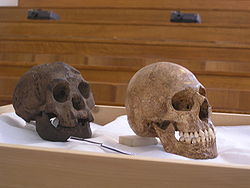
Brown and Morwood countered by claiming that the skeptics had drawn incorrect conclusions about bone and skull structure and mistakenly attributed the height of H. floresiensis to microcephaly. Falk's team replied to the critics of their study (Falk et al. (2006)). Morphologist Jungers examined the skull and concluded that the skeleton displays "no trace of disease". Argue, Donlon, et al. (2006) rejects microcephaly and concludes that the finds are indeed a new species.
Falk et al. (2007) offered further evidence that the claims of a microcephalic H. sapiens were not credible. Virtual endocasts of an additional nine microcephalic brains and ten normal human brains were examined, and it was found that the floresiensis skulls are similar in shape to normal human brains, yet have unique features which are consistent with what one would expect in a new species. The frontal and temporal lobes of the floresiensis brain were found to be highly developed, in strong contrast to the microcephalic brain, and advanced in ways different from modern human brains. This finding also answered past criticisms that the floresiensis brain was simply too small to be capable of the intelligence required for the members of H. floresiensis to create the tools found in their proximity. Falk et al. (2007) conclude that the onus is now upon the critics that continue to claim microcephaly to produce a brain of a microcephalic that bears resemblance to the floresiensis brain.
Falk's argument was supported by Lyras et al. (2008) in that 3D-morphometric features of the skulls of microcephalic H. sapiens indeed fall within the range of normal H. sapiens and that the LB1 skull falls well outside this range. This was interpreted as proving that LB1 cannot, on the basis of either brain or skull morphology, be classified as a microcephalic H. sapiens.
In 2009, a study by Jungers et al. presented a statistical analysis of skull shapes of healthy modern humans, microcephalic humans, and several ancient human species, as well as H. floresiensis. They showed that the three grouped separately, with H. floresiensis among the ancient humans, providing evidence that H. floresiensis is a separate species instead of a diseased modern human.
Laron syndrome hypothesis
The anatomist Gary D. Richards introduced a new skeptical hypothesis in June 2006: that the skeletons from Flores might be the remains of people who suffered from Laron syndrome, a genetic disorder first reported in 1966. The next year, a team including Laron himself published a paper arguing that the morphological features of H. floresiensis are essentially indistinguishable from those of Laron syndrome.
The team said that to determine whether the H. floresiensis individuals had Laron syndrome would require testing their DNA for the presence of the defective genes, if samples of that DNA ever become available. Critics of the hypothesis have however pointed out that despite the low stature, people suffering from Laron syndrome look nothing like the Homo floresiensis remains, particularly in the anatomy of the cranial vault.
Endemic cretinism hypothesis
In 2008 Australian researchers Peter J. Obendorf, Charles E. Oxnard, and Ben J. Kefford suggested that LB1 and LB6 suffered from myxoedematous (ME) endemic cretinism resulting from congenital hypothyroidism and that they were part of an affected population of H. sapiens on the island. This disease, caused by various environmental factors including iodine deficiency, is a form of dwarfism which can still be found among the local Indonesian population.
Affected people, who were born without a functioning thyroid, have both small bodies and reduced brain size but their mental retardation and motor disability is not as severe as with neurological endemic cretins. According to the authors of the study, the critical environment could have been present on Flores approximately 18,000 years ago, the period to which the LB fossils are dated. They wrote that various features found on the fossils, such as enlarged pituitary fossa, unusually straight and untwisted tops of the upper arm bone and relatively thick limbs, are signs of this diagnosis. The double rooted lower premolar and primitive wrist morphology can be explained in this way as well. The oral stories about strange human-like creatures may also be a record of cretinism.
Falk challenged the premise of Oberndorf et al. Studying computer tomography scans of LB1's pituitary fossa, she came to the conclusion that it is not larger than usual. Peter Brown declared that the remains of the pituitary fossa were very poorly preserved and no meaningful measurement was possible..
In a paper delivered to the Australasian Society for Human Biology in 2009, Colin Groves and Catharine FitzGerald compared the Flores bones with those of ten people who had had cretinism, focusing on anatomical features which are typical of the disease. They found no overlap, and stated that they had put the claim to rest. However, an article by Oxnard, Obendorf and Kefford rejects Groves and FitzGerald's argument and revives the cretinism hypothesis. Oxnard and colleagues also criticise the cladistic analysis of Argue et al. (2009), stating that it is not logically possible for the analysis to conclude that the Liang Bua remains represent a separate species and not a pathology because the cladistics analysis assumes that they do not represent a pathology.
Brown (2012) compared skeletal and dental morphology in H. floresiensis with the clinical and osteological indicators of cretinism, and the traits that have been argued to be associated with ME cretinism in LB1 and LB6. He concludes that LB1 and LB6 H. floresiensis are not modern human (H. sapiens) cretins.
Late-surviving species of early Homo hypothesis
Evidence supports the hypothesis that Homo floresiensis is a late-surviving species of early Homo with shared morphological similarities of the early African pre-erectus/ergaster hominins. This hypothesis provides a more reasonable explanation for H. floresiensis than previously established hypotheses about genetic mutations, diseases, and disordered growth. None of the current explanations account for the range of features observed in H. floresiensis, nor do they provide explanations for why a pathological condition in modern humans would mimic so closely the morphology observed in earlier hominins.
Bone structure
The bone structure of H. floresiensis’ shoulders, arms and wrists has been described as very different from modern humans', much closer to the bone structure of chimpanzees or an early hominin. This adds support to the idea that H. floresiensis is a separate species of early human rather than a modern human with a physical disorder.
Susan G. Larson et al. analyzed the upper limb of LB1. They found that in LB1 the angle of humeral torsion is much less than in modern humans. This had been previously studied by Richards et al., who declared that it is a sign of modern pygmy populations, and T. Jacob et al., who pointed out that muscle attachments on the bone suggest LB1 had weak muscles which resulted in little development of humeral torsion. Larson et al. rejected Richards’ conclusion, arguing that the humeral torsion of pygmy populations is usually similar to that of peoples of average stature. They argued that Richards et al. cited a 1972 paper which had studied a sample of six female Eastern Central African pygmies and this sample was too small to represent the whole population. Larson et al. also failed to find signs of microcephaly on the studied bones.
Larson et al. also studied the relatively short clavicle and the unusual formation of the pectoral girdle. They compared their finding with the skeleton of Nariokotome Boy (variously classified as H. ergaster or H. erectus), and suggested that the pectoral girdle of H. floresiensis was a transitional stage in human shoulder evolution.
While some specialists, including paleoanthropologist Russell Ciochon of the University of Iowa, supported the conclusion, others, including Eric Delson of Lehman College, City University of New York, pointed out that the recent sample of H. floresiensis individuals is too small and that Larson's research was based just on one shoulder bone.
Tocheri et al. (2007) (including Morwood, Larson, and Jungers), compared three carpal bones believed to belong to LB1 with carpal bones of modern humans, some earlier hominids and African apes. They concluded that the carpals from the Liang Bua cave resembled ape carpal bones and were significantly different from the bones of H. sapiens, Homo neanderthalensis or even Homo antecessor, and that they were comparable to carpal bones of Australopithecus. The carpal bones of H. floresiensis were found to lack features that evolved with ancestors of modern humans at least about 800,000 years ago. These features are already formed during embryogenesis and therefore Tocheri et al. argue that it is improbable that the shape of H. floresiensis wrist bones could be a result of a developmental disease. This evidence also suggests that H. Florensiensis is not a modern human with an undiagnosed pathology or growth defect, but that it represents a species descended from a hominin ancestor that branched off before the origin of the clade that includes modern humans, Neandertals, and their last common ancestor.
This conclusion was challenged by Robert Martin, since Jacob's death the leading proponent of the microcephaly hypothesis, and Alan Thorne. Martin noted that no research has been done on wrists of microcephalic people. Thorne maintained that the differences were small and that similar variation could occur with living modern humans. He also pointed out that the carpal bones had been found scattered in the cave and it was not certain that they all belonged to the same individual. Project leader Morwood countered that there were also other features, such as the stature, body proportions, brain size, shoulder, pelvis, jaw, and teeth which suggested that H. floresiensis is a separate species that evolved in isolation on the island.
Opposition of multiregionalists
Supporters of H. floresiensis such as Chris Stringer and Dean Falk attribute opposition partly to the fact that the existence of the species challenges the theories of multiregionalists, who believe that Homo sapiens was the only living species of hominin, evolving simultaneously in different regions, at the time when the Flores individuals were alive. Early multiregionalist critics included Alan Thorne and Maciej Henneberg.
DNA extraction
In around 2006, two teams attempted to extract DNA from a tooth discovered in 2003 - both teams were unsuccessful. It has been suggested that this happened because the dentine was targeted, whereas new research suggests that the cementum has higher concentrations of DNA. Also, the heat generated by the high speed of the drill bit may have denatured the DNA.
Name controversy
In October 2012, a New Zealand scientist due to give a public lecture on Homo floresiensis was told by the estate of The Hobbit author J.R.R. Tolkien that he was not allowed to use the word "hobbit" in promoting the lecture.
Also in 2012, an American studio called The Asylum planned to release a movie depicting people of the race Homo floresiensis. The film was indefinitely blocked from release due to a legal dispute about using the word "hobbit."
